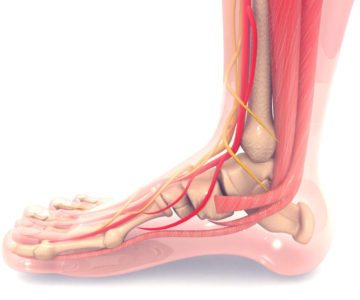 The peroneal tendons stabilize the ankle and foot. These tendons (structures that connect muscle to bone and cause movement) are found behind the outside bone of the ankle (the fibula). Tendonitis is the most common cause of pain and should be taken as a warning sign that more problems could be coming your way if you don’t actively treat the issue.
The peroneal tendons stabilize the ankle and foot. These tendons (structures that connect muscle to bone and cause movement) are found behind the outside bone of the ankle (the fibula). Tendonitis is the most common cause of pain and should be taken as a warning sign that more problems could be coming your way if you don’t actively treat the issue.
But tendonitis isn’t the only issue that can affect your peroneal tendons. After a significant ankle sprain, your peroneal tendons will become the only flexible dynamic stabilizing force after a Grade II or III ankle sprain. Left untreated, the tendons can hypertrophy over time. In many cases, chronic ankle pain due to peroneal tendon overload, tearing, and instability can develop. Other causes of peroneal tendon troubles include certain foot shapes, such as a higher arched foot, or an adducted (pigeon-toe) foot.
Peroneal Tendon Injury Symptoms
There are several symptoms that indicate a person may be dealing with a peroneal tendon injury, such as:
- Pain at the back of the ankle
- Ankle pain that does not respond to treatment
- Pain that runs from the ankle into the foot
Patients with peroneal tendonitis are usually able to walk, though they may have a limp. Severe peroneal tendonitis often prevents patients from participating in dynamic sports and other activities that require sudden changes and intense foot loading.
Peroneal Tendonitis Treatments
If a peroneal tendon injury is caught early, it can often be treated non-surgically with one or more of the following options:
- Casting or bracing
- Rest, ice and elevation
- Physical therapy
- Anti-Inflammatory medication
- Muscle toning an strengthening
Peroneal tendon problems that are left untreated can evolve into torn tendons, and these do poorly with non-surgical treatment. Activity levels need to be permanently adjusted to avoid surgery, and patients need to dive into a conservative care rehab program in order to give their tendons the best chance at a recovery sans surgery.
Snapping peroneal tendons occur when the tendons have shifted out of a normal position, and they tend to do very poorly with non-surgical treatment, as they almost always lead to tendon tearing when they run over a sharp ridge of bone. Surgery is routinely recommended in these cases.
Peroneal tendon troubles are often a sign of more chronic problems. The peroneal tendons allow us to accommodate for other injuries and disorders. When these tendons become painful, it is best to fix the whole problem.
Atlanta Personal Tendon Surgery
So if you’re dealing with any of the above symptoms, or you have reason to believe there is an issue with your peroneal tendons, reach out to Dr. Silverman and his team to take care of the issue before it snowballs. And for a list of other common orthopedic ankle and foot conditions, click here.